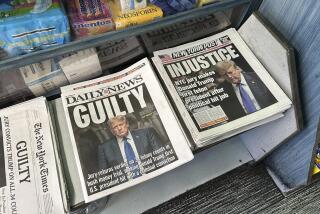Media’s Dirty Little Practices Split Seeing From Believing
- Share via
A recent TV Guide cover illustration of Oprah Winfrey, looking sensational in a seductive, leggy pose on a stack of money, was an eye-catcher. It was also a fraud.
We all know by now that we were duped, fooled, bamboozled, tricked, deceived. The only thing that was Oprah’s was her head. The body, the dress, the pose were Ann-Margret’s--and almost 10 years old. The incident is by no means trivial. It should have responsible journalists and the entire reading public steaming mad and genuinely concerned about the media’s commitment to truth.
Apparently, TV Guide editors, without the permission of either Winfrey or Ann-Margret, decided to make the composite to create an “effect.” The magazine’s 15 million readers thought they saw a photo, so realistic was the composite. It created a totally false impression of what Winfrey really looked, dressed and posed like.
Nothing in the magazine indicated that the illustration was a composite. The hoax was revealed when the designer of Ann-Margret’s dress recognized his creation.
This comes in the wake of revelations that ABC News introduced a similarly deceptive element into network news coverage--the photographic re-creation. ABC showed its viewers what appeared to be a grainy photo of spy suspect Felix Bloch handing something to a KGB agent. Only later was it revealed that the “photo” was a fabrication--a re-enactment, the network said. ABC also said later that the airing of the photo was a mistake.
The nation’s news media have responded with surprising calm to these shocking instances of journalistic deception. What happened to all that righteous indignation we saw when the press learned that White House spokesman Larry Speakes had invented quotes for Ronald Reagan? Remember all the sermonizing about the importance of truth and credibility?
TV Guide’s stunt and ABC’s venture into artistic re-creation could be watermark events in journalism because they were seen by so many millions of people. This kind of blatant fakery should be roundly condemned and clearly disclaimed by serious journalists. Every news organization should develop a clear policy and communicate it to readers and viewers.
A photograph, because of its capacity to reproduce an exact likeness or image, has always held a persuasive power that words lack. Until recently, the validity of photographic images has, for the most part, not been questioned.
“I’ll believe it when I see it,” and “seeing is believing,” are phrases that reflect our inherent confidence in visual evidence. TV Guide and ABC are unintentionally contributing to the desensitization of the public’s ability to be moved by pictures. Our emotional reactions to photos in newspapers and magazines run the risk of being dulled if we doubt that the photo is real.
The cost could be immense. What if the shocking pictures and films that made their way from the battlefields of Vietnam had been greeted by a skeptical public whose confidence had been undermined by knowledge that journalists not only can but will manipulate images to make or enhance a point?
What if that photograph of Donna Rice on Gary Hart’s lap had raised as many questions about the possible “monkey business” of the newspaper as it did about the senator?
What about the remarkable picture of the lone Chinese man standing in front of a line of tanks outside Tian An Men Square in defiant opposition? What if we instinctively wondered whether it was simply the work of an imaginative special-effects expert? The Chinese government’s denials were made ludicrous by pictures sent us by credible journalists.
The instances of fakery by TV Guide and ABC are important because a wide audience now knows of its vulnerability to illusion-makers. But insiders know of other dirty little practices.
For example, news organizations regularly use an airbrush to erase blemishes and unwanted images, not only to make people look better but also to advance the paper’s agenda. The prestigious Christian Science Monitor has been known to delete cigarettes from the hands of photo subjects, even taking the emblematic cigar from Winston Churchill.
Where credibility is so important, there are no petty or harmless deceptions, no little white lies.
The technology of digital alteration produces undetectable changes with lightning speed and seems to beg to be used. It can tempt even the most staid organizations. According to a recent Washington Journalism Review article by J. D. Lasica, a features editor and columnist for the Sacramento Bee, National Geographic editors in 1982 approved the digital moving of one of the Great Pyramids closer to another so both would fit on the cover. To its credit, the magazine has since adopted a strict policy against such alteration of reality.
Lasica’s conclusion is apt and foreboding: “Faster than you can say ‘visual credibility gap,’ the 1980s may be the last decade in which photos could be considered evidence of anything.”
What a terrible pity that would be.
More to Read
The complete guide to home viewing
Get Screen Gab for everything about the TV shows and streaming movies everyone’s talking about.
You may occasionally receive promotional content from the Los Angeles Times.






